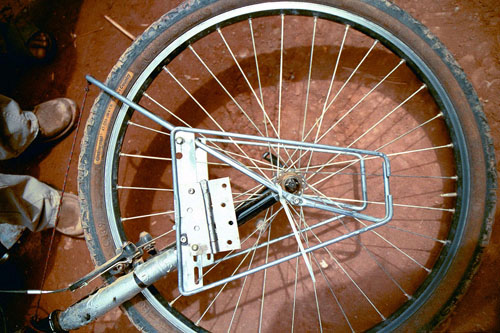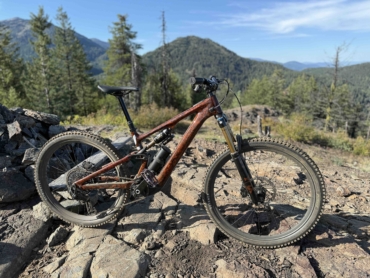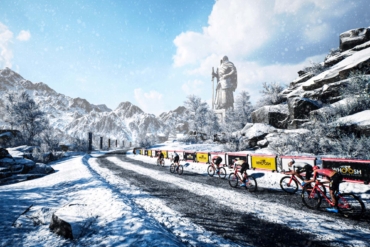The bicycle that carried Scott Stoll around the world doesn’t look like anything special. There’s tape on the frame and extra washers to hold racks in place. Its black paint is chipped. The leather saddle is faded and worn, a dented anatomical imprint testimony to the months and thousands of miles Stoll sat pedaling on a quest to travel around the planet on two wheels.
The bicycle, a customized mountain bike with a steel frame made by Waterford Precision Cycles, served for four years as Stoll’s vehicle for discovery. It is a star in his new book, “Falling Uphill: 25,742 miles, 1,461 days, 50 countries, 6 continents & 4 moments of enlightenment on a bicycle.”

(Click for ‘BIKE AROUND THE WORLD’ PHOTO GALLERY)
I met up with Scott in Minneapolis, where he was on a book tour. His latest trek, a circumnavigation of North America, began last March. He’s on the same Waterford bike. And the same Shimano shoes he’s had since Australia.
Indeed, Stoll’s long ride has served as an ultimate gear test for bike-touring equipment. Over the months and years on the road, he has formed some strong opinions on what gear works — and what fails in the field.
“By brute determination and sheer human power, I’ve worn down steel, cracked aluminum, snapped titanium, and rubbed my handlebars smooth as glass with my hands,” he once wrote on his blog, www.TheArgonauts.com.

(Click for ‘BIKE AROUND THE WORLD’ PHOTO GALLERY)
The Waterford bike, which is built on the Gunnar Rockhound frame model (gunnarbikes.com/rockhound), has now gone more than 31,000 miles, Stoll estimates. On his big trip, he carried spare parts — including chains, tires and other major items — when he coasted into countries ranging from Kenya to New Zealand.
Along the way, Stoll said everything on the bike was replaced at least once except for the frame, the handlebars and a rear rack made by Jandd. “The Jandd Expedition rack is amazing,” he said. The reinforced aluminum rack was designed for “carting firewood or portaging large containers of water,” according to its description on www.jandd.com. It costs $84.95.
Another brand-name rack company, which has less expensive models, did not fare so well: “Blackburn racks are no good — I ruined two of them,” Stoll quipped.

(Click for ‘BIKE AROUND THE WORLD’ PHOTO GALLERY)
He toted food, water and dozens of items on the road, including camping gear. Ortlieb’s Back Roller Classic panniers served as saddle bags for all manner of miscellany. He said the $165 waterproof bags (www.ortliebusa.com) survived four years of wear.
The aforementioned leather bike saddle — which shaped itself over a few months to Stoll’s backside for a custom fit — is something he calls “The best thing I’ve ever bought.” It is made by Brooks, a U.K. company (www.brookssaddles.com). The model name is the Flyer, and it costs $122. Beyond the fit, Stoll said the retro saddle’s large springs absorbed bumps, improving his comfort, performance, and endurance on long days.
He went through several sets of tires while pedaling on roads, trails, dirt, mud and cobblestone. The Schwalbe Marathon Plus tire, which has a 5-mm-thick layer of rubber for puncture protection, is by Stoll’s account “the best touring tire in the world.”

(Click for ‘BIKE AROUND THE WORLD’ PHOTO GALLERY)
The Marathon Plus tires, which cost $55 apiece, are cited by the company as impenetrable even by shards of glass and thumb tacks. Stoll went 15,000 miles on one set.
Stoll also tried Continental’s Top Touring tire model, which failed his test. “They were too tight, too small for the rims, and the beading and sidewall kept getting destroyed when I had to take them off to change a flat,” he said.
For the wheels, Stoll recommends downhill mountain biking rims. “Go double-walled with at least 36 spokes,” he said. Over the years, he has used multiple rim models from Mavic (www.mavic.com), and he said they all “worked perfectly.”

(Click for ‘BIKE AROUND THE WORLD’ PHOTO GALLERY)
For components — shifters, derailleurs, and brakes — Stoll used Shimano’s Deore LX line, which he describes as “heavy duty, long lasting, mid-range-priced stuff.”
He used shoes and pedals from Shimano, too. He doesn’t know the model names of either. “The markings and model numbers have been long worn off.”
He said most of the Shimano products held up all the way around the world. The rear hub actually cracked after 30,000 miles, but it still didn’t fail. Now that’s a serious gear test.
As for the bike frame — which he long ago named “Yerba” — it is made of steel and could last a lifetime, he said. But after his book tour around North America this year, Stoll plans to bring it home and retire the bike. He plans to hang it on a wall.
—Stephen Regenold writes about outdoors gear at www.gearjunkie.com.






